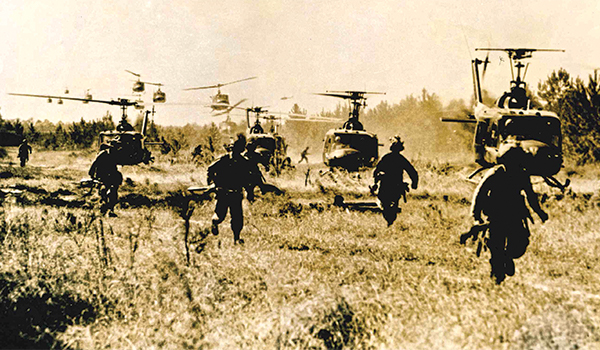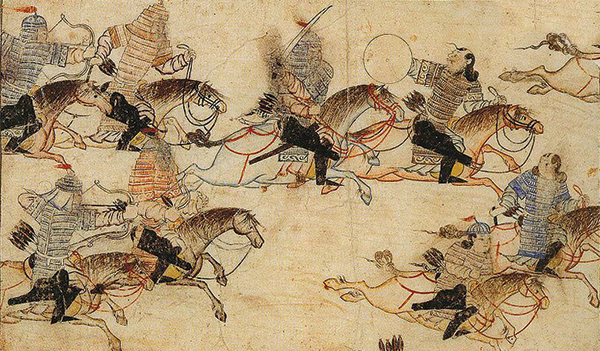
Historical Perspective / By Mark Albertson: The history of war is the story of Man attempting to foster mobility for decisive advantage on the battlefield. – Mark Albertson

Vietnam – The Helicopter War / AAPI FILE PHOTO (Feb 66 Issue)
The chariot was an early expression of mobility on the battlefield; employed for military purposes during the Bronze and Iron Ages. The Assyrian Army, considered by some military historians as the world’s first professional army, employed the chariot to great advantage. Early light chariots, each with driver and archer and a team of two horses, was an early weapons support vehicle for infantry. Groups of chariots would shower enemy formations with arrows, and do so from different quarters, as the Assyrian infantry launched its assaults.
Richard Gabriel and Karen Metz wrote of larger Assyrian chariots, pulled by three horses and crewed by a driver and three infantrymen. “The idea was to attack the enemy formations from as many directions as possible. Once engaged the crews dismounted and fought as infantry, and their use of the chariot strongly parallels the use of armored carriers in modern armies.”
The Assyrian Army’s ability to fight in a variety of terrain and conditions made it the most fearsome of competitors; even to employing reed boats to cross or fight on swamps, marshes or rivers. The Assyrian prowess at military engineering included bridges of palm wood and reeds, a forerunner of modern pontoon bridges.
Enter the Cavalry
But the chariot as a primary military tool was superseded by the mounted horseman. The Assyrians are credited with having developed cavalry. Mobility in war became highly flexible; as the mounted arm proved adept in terrain hardly conducive to the chariot. Reconnaissance and flank security for an advancing army bolstered the cavalry’s tactical capabilities, as well as enhancing the notion of shock.

YOUR CAPTION HERE
In addition, the Assyrians developed an all-weather capability to warfare. In 714 B.C., the campaign into Armenia was conducted 600 miles from Nineveh, the Assyrian capital. This fall-winter campaign, combining infantry, cavalry and chariots traversing heavy snows and mountain passes, showcased the Assyrian talent for mobility and adaptability in war.
But it is with the nomads of the Asian steppe where maneuver and mobility are taken to those levels of excellence for an unrivaled success in war. And the epitome of maneuver and mobility was that of an army that was arguably the most successful armed force in the history of war; an army able to exact a contiguous empire from Vladivostok to the Polish frontier and into the Near East – the Mongols. In any dictionary of military jargon, only one picture should be placed beside the definition of “mobility,” that of a Mongol cavalryman.
We begin with that engine of mobility, the horse; or rather, the Mongol pony. Smaller and stockier than other strains, with shorter, thicker legs, coarse hair and longer manes and tails, this was a rugged mount bred for protracted Mongol campaigns in some of the most challenging of environments. The Mongol warrior was bred for war starting at age 2 or 3, to ride, shoot a bow and wield a knife, sword and lance. Techniques employed in the hunt, herding and survival were used in war. A Mongol’s life was spent in constant preparation for war. And this took in an age group from 16 to 60.
Disciplined Warriors and Tactics
Genghis Khan’s army was hardly a disorganized mob; boasting, instead, definite formations: Arban, ten men; Jaghun, 100 men; Mingghan, 1,000 men and the Tumen, 10,000 men.Discipline was swift and sure. Sentries found asleep at their posts – executed. Following a defeat in Syria, 5,000 Mongols, bereft of horses and cast afoot, were left to walk back to their base; a two-month trek. After which, on fresh mounts, they threw themselves into another campaign. Such was the discipline of the Mongols.
Mongol horsemen used tried and true tactics from the steppe: hit and run, sometimes in waves, showering a foe with arrows; attack against an enemy’s rear and flanks; encirclement; relentless pursuit of a foe with annihilation as the objective; together with hounding the leader of the conquered land until his capture and demise; and, the feigned retreat.
The feigned retreat was a classic steppe tactic. A Mongol force would sell the fiction of relinquishing the battlefield. The resulting withdrawal was designed to goad the enemy into giving chase; a planned retirement which could last days. Then, at the precise moment, at that point of using advantageous terrain, the retreating steppe warriors would reverse course, joined by other cavalry formations converging from the flanks. This tactic served, too, to provide the Mongols the advantage of avoiding close-in-combat until it was to their benefit.
Mobility, in turn, was accentuated by the Mongol Army’s ability to subdivide itself into more manageable forces to avoid contact, only later to coalesce and effect the encirclement then destruction of a foe. Such was how Genghis Khan destroyed the Khwarazmian Empire.
Transition to Modern Times
The tactic of subdivision of forces is precisely what Lieutenant General Roy S. Geiger, Commander, Fleet Marine Force Pacific, offered after witnessing the 1946 Bikini Island atomic bomb tests. In a letter to General Alexander Vandergrift, Commandant of the Marine Corps, Geiger explained that in the face of atomic weaponry, it was no longer feasible to launch amphibious assaults, such as those at Sicily, Normandy and Okinawa. Rather, light aircraft (to which helicopters were later included) would be used to disperse assault forces over a broader area; then, at the opportune time, use these aerial assets to mass the troops for battle – hence, the Vertical Assault concept.
The Assyrian use of the chariot was a forerunner to the Huey helicopter in Vietnam. For instance, chariots with archers acting as mobile weapons support platforms was a concept not altogether different than the Army’s employment of the helicopter in Vietnam, including that of landing to pick up or drop off troops. But the slashing use of cavalry by the steppe people provided those examples of mobility, later followed by such theorists as J.F.C. Fuller and Basil Liddell Hart, with regards to armored warfare.
Yet the Mongols’ unrivaled ability to cover huge swathes of a battlefield was certainly a model for the Airmobility Concept to emulate. In the end, the basic idea is the same – it is the technology that has changed.
Mark Albertson is the award-winning historian for Army Aviation Publications, Inc.










